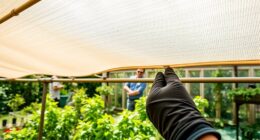To achieve a year-round harvest, you should plan your garden with succession planting strategies, staggering crop sowings to maximize space and extend harvest times. Rotate different plant varieties to maintain soil health and reduce pests, ensuring continuous productivity. Start with early crops, then replace them with mid and late-season plants, adjusting for growing seasons. Keep experimenting with timing and crop choices—more tips await to help you maximize your garden’s potential.
Key Takeaways
- Plan crop sequences based on growth seasons to ensure continuous harvests throughout the year.
- Use quick-maturing crops like lettuce and radishes to fill gaps between main crops.
- Rotate crops regularly to maintain soil fertility and reduce pest and disease buildup.
- Stagger sowings of the same crop to prevent glut and ensure steady supply.
- Incorporate season extension techniques such as cold frames or row covers to extend growing periods.

Succession planting is a smart strategy to maximize your garden’s productivity by planting crops in a planned sequence. This technique guarantees you’re constantly harvesting, making the most of your growing space throughout the year. One of the key elements to successful succession planting is understanding crop rotation. By rotating different types of plants—such as leafy greens, root crops, and legumes—you prevent soil depletion and reduce the risk of pests and diseases. Crop rotation helps maintain soil fertility because certain plants, like legumes, fix nitrogen in the soil, enriching it for future crops. When you follow this practice, your garden remains healthy and productive, reducing the need for chemical fertilizers and enhancing overall soil structure.
Maximize garden productivity with crop rotation to prevent soil depletion and boost soil health.
As you plan your succession planting schedule, keep in mind how different crops impact soil fertility. Fast-growing vegetables like radishes or lettuce can be sown after longer-season crops like tomatoes or peppers. This approach allows you to utilize the same space efficiently without leaving it empty for long periods. By carefully timing your plantings, you guarantee that your soil is continually nourished and not overused. For example, after harvesting a crop of beans, you might plant a leafy green like spinach, which benefits from the residual nutrients left behind. This cycle helps sustain soil health while providing a steady stream of fresh produce.
Another benefit of succession planting is that it allows you to adapt to seasonal changes and extend your harvest window. As one crop finishes, you can quickly sow another, ensuring a continuous supply of vegetables. To achieve this, you need to be mindful of each crop’s growing season and maturity time. Planning ahead is vital; you might start with early crops like lettuce and radishes, then switch to mid-season plants such as carrots or beets, followed by late-season favorites like kale or Brussels sprouts. This sequential planting keeps your garden productive year-round.
Furthermore, succession planting encourages you to experiment with different crop varieties and planting techniques. You can stagger sowings of the same crop every few weeks, which prevents glut and gives you a regular harvest. Rotating crops also reduces soil fatigue, a condition where certain plants deplete specific nutrients, making subsequent crops less productive. By combining crop rotation with succession planting, you create a resilient garden system that sustains itself while maximizing yields. Incorporating soil health practices can further enhance your garden’s productivity and sustainability.
Frequently Asked Questions
How Do I Plan Succession Planting for Small Gardens?
To plan succession planting in your small garden, start by mapping out your crops’ growth cycles and planting new ones just as the previous harvest finishes. Focus on maintaining soil fertility with compost and organic fertilizers to support continuous growth. Incorporate pest management strategies like companion planting and timely removal of pests. This approach guarantees a steady harvest, maximizes space, and keeps your garden healthy year-round.
What Are the Best Crops for Year-Round Succession Planting?
Imagine a garden where vibrant greens and colorful blooms roll in a seamless wave year-round. For continuous harvest, choose fast-growing crops like lettuce, radishes, and spinach, rotating them regularly to maintain soil fertility. Incorporate crop rotation to prevent disease and replenish nutrients, ensuring your soil stays healthy. By planning your succession planting carefully, you’ll keep your garden productive and lively, no matter the season.
How Can I Avoid Overplanting and Crop Overlap?
To avoid overplanting and crop overlap, plan your planting schedule carefully, considering crop rotation and ideal planting density. Space out your plantings based on each crop’s growth rate, and stagger sowings to ensure continuous harvests without overcrowding. Keep detailed records of what you plant and when, so you can adjust your timing accordingly and maintain a balanced, productive garden year-round.
What Tools Help Manage Multiple Plantings Efficiently?
To manage multiple plantings efficiently, use a garden calendar and a detailed planting schedule. These tools help you track sowing dates, harvest periods, and crop rotations, reducing overlaps. You can also set reminders for successive plantings, ensuring continuous harvests. By planning ahead with these tools, you stay organized, avoid overplanting, and maximize your garden’s productivity year-round.
How Do I Adjust Succession Planting for Unusual Climate Conditions?
Like a seasoned sailor steering unpredictable seas, you adapt your succession planting by embracing climate adaptation and soil modification. You can extend your growing season by choosing resilient varieties and adjusting planting times. Incorporate soil amendments to boost fertility and moisture retention, helping crops withstand unusual weather. Monitor weather patterns closely, and be ready to shift planting schedules or select alternative crops, ensuring a continuous harvest despite climate uncertainties.
Conclusion
By mastering succession planting, you’re weaving a vibrant, never-ending tapestry of harvests. Each planting becomes a brushstroke in your garden’s masterpiece, ensuring freshness and abundance all year round. With patience and planning, you’ll keep your garden’s heartbeat steady, like a well-tuned symphony. So, embrace these strategies, and watch your garden flourish into a perpetual feast—a living, breathing affirmation to your green thumb’s artistry. Your harvest season is just a planting away.









